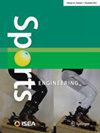Towards statistical analysis of predictive parameters in competitive speed climbing
IF 1.4
Q3 SPORT SCIENCES
引用次数: 0
Abstract
Abstract Competitive sport climbing progressed massively within the last quarter century. Development of technology enabling qualitative and quantitative analysis is required to withstand the challenges for athletes and trainers. This paper deals with the statistical study of a data set generated by the application of several image processing algorithms and neural networks on competition recordings. Therefore, calculated parameters are combined with random variables for the implementation of a linear mixed effect model. The resulting model enables the prediction of the end time of different athletes and the determination of its correlation with the input variables. Furthermore, analysis of velocity and path of the centre of gravity in different wall sections is done for all available speed climbing athletes. The observed data set consists of 297 runs in total divided into two subsets of 202 observations of 47 male and 95 of 25 female athletes. Among others, the statistical model was used for the validation of the measured parameters and the review and impact of proven techniques like the Tomoa skip in the start section. Likewise interesting is the high influence of the parameters, measured especially in the middle section of the wall, on the end time.竞技速度爬坡预测参数的统计分析
竞技攀岩运动在过去的25年里取得了巨大的发展。技术的发展,使定性和定量分析是必需的,以承受运动员和教练的挑战。本文对几种图像处理算法和神经网络在比赛记录上的应用所产生的数据集进行了统计研究。因此,计算参数与随机变量相结合,实现线性混合效应模型。所得到的模型能够预测不同运动员的结束时间,并确定其与输入变量的相关性。此外,还分析了所有速度攀爬运动员在不同壁段的速度和重心路径。观察到的数据集由297个运行组成,分为两个子集,其中有47名男性运动员的202个观测值和25名女性运动员的95个观测值。其中,统计模型用于验证测量参数,以及审查和影响已证实的技术,如开始部分的Tomoa跳过。同样有趣的是参数的高度影响,尤其是在墙的中间部分,对结束时间。
本文章由计算机程序翻译,如有差异,请以英文原文为准。
求助全文
约1分钟内获得全文
求助全文
来源期刊

Sports Engineering
SPORT SCIENCES-
CiteScore
2.40
自引率
17.60%
发文量
23
期刊介绍:
Sports Engineering is an international journal publishing original papers on the application of engineering and science to sport. The journal intends to fill the niche area which lies between classical engineering and sports science and aims to bridge the gap between the analysis of the equipment and of the athlete. Areas of interest include the mechanics and dynamics of sport, the analysis of movement, instrumentation, equipment design, surface interaction, materials and modelling. These topics may be applied to technology in almost any sport. The journal will be of particular interest to Engineering, Physics, Mathematics and Sports Science Departments and will act as a forum where research, industry and the sports sector can exchange knowledge and innovative ideas.
 求助内容:
求助内容: 应助结果提醒方式:
应助结果提醒方式:


